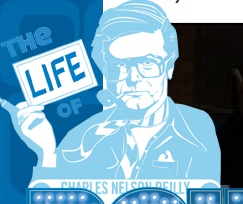See a photo of Barry, his bio, Part 1 of this Q&A, Part 2, Part 3, and Part 4.
Q&A with Barry Poltermann, Questions 9, 10, 11, and 12:
Q: What’s your favorite story about a transformation that came about through a story or storytelling act?

A: We made a film called “Life of Reilly”, about
Charles Nelson Reilly. The film got limited release, but I keep getting emails from people who are inspired by it. Unexpectedly. Literally “it changed my life” kinds of emails. “I quit my job and became a teacher”, and “I came out of the closet to my parents” type of emails. To be involved in a film that changed peoples lives … kind of cool.
Q: What future trends or directions to do foresee for story/storytelling/narrative? What’s next for the discipline?
A: Is it too flowery to say that stories are the essence of what binds us as human beings? It’s true, so what the hell. From the earliest oral tradition of storytelling and the stories that were crudely painted on the inside of cave walls to the newest 3D Hollywood spectacular and everything in between — stories are at the core of what we are as people. I think we’ll see bigger stories and smaller stories and less in the middle. Meaning, I think we’ll see more Avatar in 3D and more AboutFace-Media-style short videos and stories told through social experiences online; but I think we’ll also see less in the middle. Fewer scripted television shows, fewer mid-budget feature films, fewer television commercials. Bigger and smaller — but it’s just the economics of exploiting story. Great stories will always be told. We have no choice. It’s in our nature.
Q: If you could share just one piece of advice or wisdom about story/storytelling/narrative with readers, what would it be?
A: If you’re interested in telling stories and getting good at it, do it all the time. Study great stories. Study the formulas. Study the masters. And tell your stories. All the time. Then, if you’re good at it, hopefully you’ll be able to do it successfully in your career. We at AboutFace are always looking for great storytellers, and I know a whole lot of other companies are, or will be soon, too.
Q: You say on the video clip on your site that your company chose to focus on video because it’s the fastest-growing segment of Web 2.0. In what ways does video lend itself to the kinds of stories you want to tell for your clients?
A: Video is an amazing medium for storytelling. It is lean, it is mean, it is efficient as all get out. Our clients need their story to be told in an authentic way. The web and its denizens are very adept at smelling out an ad. Anything that feels like hard-selling is going to be clicked off very quickly. These are people who are online. They have all the power. It’s not like the old days of TV where the audience had to sit and watch the commercials and wait until their show was back on. Web users know they don’t need you, and they watch you literally leaning forward with their hands on the keyboard, ready to chop off your head if they are not amused. So, rather than try to shove a message down their throats to no avail, we use documentary videos to tell them a story. It’s a different story from client to client, but the point is that we’re communicating each client’s message while offering the savvy web user something of value — a compelling story of interest to them. It’s not a hard-sell Super Bowl ad. It’s a story that puts a human face on the client and delivers the message in a framework that won’t get users clicking off because they smell a hard-sell ad. Why video? Video is imperative to our storytelling. It gives you the freedom and cost-effective ability to shoot, edit, and polish a lot of high-quality stories for a tiny fraction of what that would have cost only 10 years ago if you had to do it on film. And that doesn’t even get into the distribution side of video — being able to upload your video to all of the big sharing sites, your own site, the social-media communities at no extra cost would have been unthinkable even a decade ago. Video also is hugely advantageous for our stories and our clients because it is growing online so rapidly. Look, we all know that the point of making these videos for our clients is to get them seen by the target audience. With that target audience growing online, and watching more and more videos online, it just makes the whole process and end result that much more of a no-brainer. And, again, it costs just as much to put the video on 10 video-sharing sites as it does on one. The growth of video consumption is a key to why we’ve been able to not only get work but flourish.
